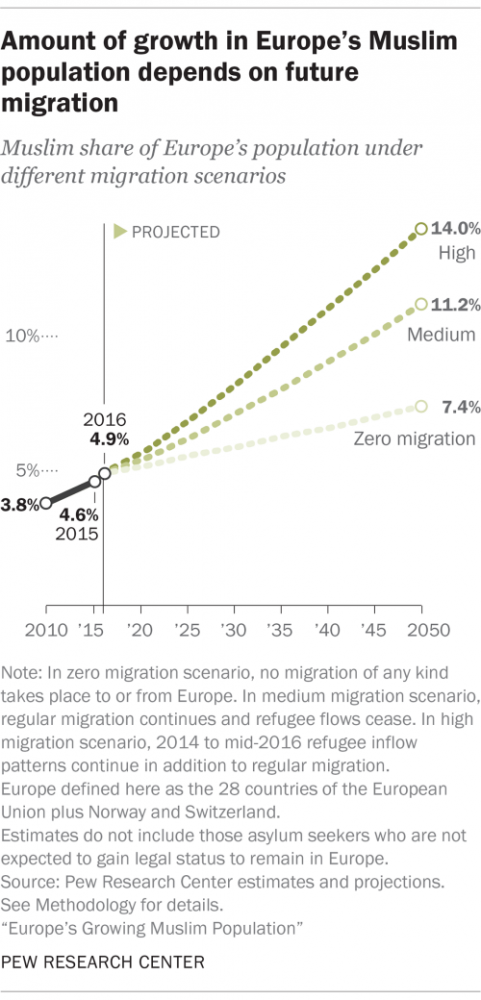
Even if migration to Europe ceased – no immigrants, no refugees – the percentage of Muslims in those countries would still rise over the next three decades.
That’s according to new projections released Wednesday by the Pew Research Center.
Though it hasn’t been long since Pew made its last projections on population growth of world religions, which were based on 2010 numbers, a record number of asylum seekers from Syria and other predominantly Muslim countries has changed the picture considerably.
As of mid-2016, Muslims make up nearly five per cent of the population in the 28 countries of the European Union, plus Norway and Switzerland, according to the new Pew report. That’s an estimated 25.8 million people – fewer than Pew originally estimated. It’s up from 19.5 million (or nearly four per cent of the population) in 2010.
By comparison, Muslims make up about one per cent of the population in the United States and could reach two per cent by 2050, according to Pew estimates released earlier this year.
The new European numbers are based on Pew analysis and projections of census and survey data from each country, as well as data on immigration from Eurostat and other sources.
With the recent wave of Muslim immigrants and refugees to Europe, anti-Muslim movements have sprung up in several countries, including PEGIDA (Patriotic Europeans Against the Islamisation of the West), which has protested the arrival of Muslim migrants, claiming Germany will be “overrun” by Muslims.
That sentiment can cross the Atlantic: On Wednesday, President Trump retweeted three inflammatory videos purporting to show violence committed by Muslims that had been posted by the deputy leader of the far-right group Britain First, Jayda Fransen.
How much Europe’s Muslim population actually will grow over the next three decades depends on future migration and birthrates. Pew created projections for three possible scenarios.
• If all migration to Europe stopped, the Muslim population could grow to 7.4 per cent by the year 2050. One reason for that growth is that European Muslims are younger than other Europeans by 13 years, on average. They also have more children — an average one more child per woman.
• If no more refugees were admitted into European countries as of mid-2016, but immigration continued at its current pace, the Muslim population could more than double to 11.2 per cent.
• If refugees and immigrants continued to come to Europe in similar numbers with a similar religious makeup from now until 2050, the Muslim population could nearly triple to 14 per cent.
Previously, Pew had estimated Europe’s Muslim population at nearly six per cent of the region, projecting it would reach 10 per cent by 2050.
Meantime, Europe’s total population would drop from about 521 million to an estimated 482 million without any future migration, according to the report. It would remain roughly stable if only non-refugee immigrants were admitted to the country and grow modestly if all were admitted.
The non-Muslim population is projected to decline in each scenario – at most, by about 10 per cent in the scenario with no migration.
But even the scenario with the largest growth leaves the Muslim population considerably smaller than the populations of both Christians and people with no religion in Europe, according to the report.
“There will be no country where Muslims make up more than a third of the population,” said Conrad Hackett, Pew’s associate director of research and senior demographer.
“There have been sort of sensationalistic claims that due to different fertility or migration patterns, France or other countries might perhaps have a Muslim majority by midcentury. Even in our highest scenario, we just don’t find that to be an outcome that would materialise.”





